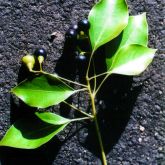Camphor laurel

Camphor laurel flowers
© Queensland Government

Camphor laurel leaves and berries
© Queensland Government

Camphor laurel infestation along roadside
© Queensland Government

Camphor laurel infestation
© Queensland Government
Native to Taiwan, Japan and parts of China, camphor laurel was introduced to Australia in 1822 as a garden ornamental. Since then, feral populations have established from the Atherton Tableland in north Queensland to Victoria. Camphor laurel is common in South East Queensland.
Camphor laurel is an attractive shade tree but can be very invasive, replacing pasture and native vegetation.
You must manage the impacts of camphor laurel on your land.
You must not give away, sell or release camphor laurel into the environment.
Scientific name
Description
- Large evergreen tree up to 20m tall.
- Leaves are glossy, waxy, smell of camphor when crushed.
- Flowers are small, white.
- Leaves are lush, bright green when new, darker green when mature.
- Fruits are spherical, berry-like, 10mm across, green at first, changing to black when ripe.
Habitat
- Particularly common along watercourses and on soil types that once supported rainforest.
Distribution
- Visit Weeds Australia and click on the distribution tab to access the distribution map.
Life cycle
- Seeds germinate after ingestion by birds.
- Seeds can stay viable up to 3 years.
- Germination occurs for 4–20 weeks.
- Produces over 100,000 seeds a year.
- Flowers in spring.
- Produces lush, bright green foliage in spring.
Affected animals
- Koalas
Impacts
Environmental
- Aggressively replaces native vegetation.
- Replaces native trees (e.g. blue gums, koalas' preferred food).
- Invades disturbed riparian systems.
- Inhibits regeneration by other plants.
Economic
- Invades pastures.
- Pushes over fences and disrupts power facilities.
- Develops massive root system that can block drains and crack concrete structures.
How it is spread
- Seeds spread by birds and water.
- Also spread through dumping of garden waste.
- Trees can sucker when under stress.
Prevention
Control
Physical control
Hand-pulling
- Hand-pull newly established or isolated seedlings.
Fire
- Fire kills plant tops but produces regrowth from base.
Mechanical control
- Remove newly established or isolated seedlings by grubbing.
- Bulldoze young trees that can be completely removed. Failure to remove roots or crowns of mature trees will result in regrowth.
Herbicide control
- Method depends on size and situation of target tree.
- Treating standing tree may create serious hazard to human safety or other structures when tree falls. Removing bulk of tree before treating stump is preferred in such situations.
Foliar spray
- Use foliar sprays for young trees up to 3m tall.
Basal bark spray
- Trees up to 6m tall with a basal stem diameter up to 30cm and no multi-stems can be treated using basal bark or cut-stump methods, although basal bark is preferred.
- When using basal bark method, spray from ground level up to 30cm or higher than where multi-stems branch.
Stem injection
- For trees taller than 6m, stem injection using modified axe is most practical – leave no more than 2cm between cuts.
- Axe cuts for stem injection of herbicides should be made at regular intervals all around stem (or stems). Care should be taken to ensure axe leaves 'pocket' in stem, into which herbicide is immediately injected. Cuts should penetrate sapwood (just under bark), but not hard central wood. Cuts made too shallow into bark or too deep into stem will result in regrowth. Drilling holes in stem before herbicide application is not recommended.
Read the camphor laurel fact sheet (PDF, 1.5MB) for herbicide control and application rates.
Biological control
- No known biological control agents.
Legal requirements
- Camphor laurel is a category 3 restricted invasive plant under the Biosecurity Act 2014.
- You must not give away, sell or release camphor laurel into the environment. Penalties may apply.
- You must take all reasonable and practical measures to minimise the biosecurity risks associated with dealing with camphor laurel under your control. This is called a general biosecurity obligation (GBO).
- At a local level, each local government agency must have a biosecurity plan that covers invasive plants in its area. This plan may include actions to be taken on camphor laurel. Some of these actions may be required under local laws. Contact your local council for more information.